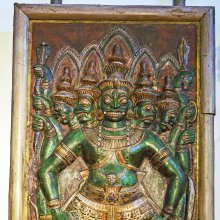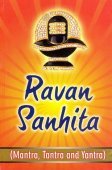Shanti, Santi, Śāntī, Śānti, Samti, Shamti: 44 definitions
Introduction:
Shanti means something in Buddhism, Pali, Hinduism, Sanskrit, Jainism, Prakrit, the history of ancient India, Marathi, Hindi, biology, Tamil. If you want to know the exact meaning, history, etymology or English translation of this term then check out the descriptions on this page. Add your comment or reference to a book if you want to contribute to this summary article.
The Sanskrit terms Śāntī and Śānti can be transliterated into English as Santi or Shanti, using the IAST transliteration scheme (?).
Images (photo gallery)
In Hinduism
Purana and Itihasa (epic history)
Source: Wisdom Library: Bhagavata PuranaŚānti (शान्ति):—Son of Nīla (son of Ajamīḍha and his wife Nalinī). He had a son named Suśānti. (see Bhāgavata Purāṇa 9.21.30-31)
Source: archive.org: Puranic Encyclopedia1) Śānti (शान्ति).—Daughter of Dakṣa by his wife Prasūti. Prasūti delivered including Śānti twentyfour children. (Viṣṇu Purāṇa, Part 1, Chapter 7).
2) Śānti (शान्ति).—A king born in the dynasty of Bharata, son of Duṣyanta. He was the son of Nīla, grandson of Ajamīḍha and father of Suśānti. (Bhāgavata, 9th Skandha).
3) Śānti (शान्ति).—Name of the Indra of the fourth Manvantara (Ādi Parva, Chapter 196, Verse 29).
4) Śānti (शान्ति).—A maharṣi. Son of Aṅgiras, he was called Ātmeyu also. He had participated in the Yajña conducted by Uparicaravasu. (Śānti Parva, Chapter 336, Verse 8; Ādi Parva, Chapter 196, Verse 20; Anuśāsana Parva, Chapter 85, Verse 130).
5) Śānti (शान्ति).—A maharṣi who was a disciple of the Ṛṣi called Bhūti, who did once go to participate in a yajña conducted by his brother Suvarccas, leaving matters connected with his āśrama with Śānti, who discharged his duties quite well in the absence of his master. One day when agni became very scarce in the āśrama he praised Agnideva, and noticing that the Deva was pleased Śānti requested him to bestow a son on the maharṣi. Accordingly a son was born to Bhūti, who later on became famous as 'Bhautyamanu.' Bhūti, who was pleased with the devout life of his disciple (Śānti) taught him Sāṅgaveda. (Mārkaṇḍeya Purāṇa).
Source: archive.org: Shiva Purana - English Translation1) Śānti (शान्ति, “peace”) is one of the twenty-four daughters of Dakṣa by Prasūti: one of the three daughters of Svāyambhuvamanu and Śatarūpā, according to the Śivapurāṇa 2.1.16:—“Dakṣa begot twenty-four daughters. Thirteen daughters Śraddhā etc. were given to Dharma in marriage by Dakṣa. O lordly sage, listen to the names of Dharma’s wives. Their names are [... Śānti (peace, calmness),...]. Thereupon the entire universe consisting of three worlds, mobile and immobile was filled (with progeny). Thus according to their own actions and at the bidding of Śiva innumerable famous Brahmins were born out of the various living beings”.
2) Śānti (शान्ति, “peace”) refers to “peace”, according to the Śivapurāṇa 2.2.43.—Accordingly, as Śiva said to Dakṣa:—“O patriarch, listen to another statement of mine with a clear conscience. Although it is based on the qualitative aspect it is esoteric. For the sake of virtue I shall tell you. Brahmā, Viṣṇu and I constitute the chief cause of the universe. But I am the soul, the witness, self-seer and without attributes. [...] He attains peace (śānti), who does not see any difference among the three deities who constitute the soul of all living beings and who have the same innate property, O Dakṣa”.
Source: Cologne Digital Sanskrit Dictionaries: The Purana Index1a) Śānti (शान्ति).—A daughter of Kardama, married to Atharvaṇa: Dadhyañca was her son. Yajña was popularised in the world by her.*
- * Bhāgavata-purāṇa III. 24. 24; IV. 1. 42.
1b) A son of Dakṣiṇā, and a Tuṣita god.*
- * Bhāgavata-purāṇa IV. 1. 7-8.
1c) A daughter of Dakṣa, and a wife of Dharma, gave birth to Sukha (Kṣema, Vāyu-purāṇa).*
- * Bhāgavata-purāṇa IV. 1. 49 and 51; Brahmāṇḍa-purāṇa II. 9. 50, 61; Vāyu-purāṇa 10. 25. 37; Viṣṇu-purāṇa I. 7. 23, 30.
1d) A son of Nīla, and father of Suśānti.*
- * Bhāgavata-purāṇa IX. 21. 30-31; Viṣṇu-purāṇa IV. 19. 57.
1e) A son of Kṛṣṇa and Kālindī.*
- * Bhāgavata-purāṇa X. 61. 14.
1f) (Kalpa) author of: a master of Atharva Samhitā.*
- * Bhāgavata-purāṇa XII. 7. 4; Brahmāṇḍa-purāṇa II. 35. 62.
1g) A river in Śālmalidvīpa.*
- * Brahmāṇḍa-purāṇa II. 19. 46.
1h) A son of Tāmasa Manu.*
- * Brahmāṇḍa-purāṇa II. 36. 49.
1i) The Indra of the gods—Sudhāmāna and Viruddhas;1 Indra of the tenth epoch of Manu.2
1j) A kalā of Hari.*
- * Brahmāṇḍa-purāṇa IV. 35. 95.
1k) A Śakti.*
- * Brahmāṇḍa-purāṇa IV. 44. 71.
1l) To avert impending evils; abhayā to get rid of fear, saumyā to get rid of disease, vaiṣṇavī against famine and fear from insects and robbers, raudrī if beasts get sick and die, brāhmī when hetrodoxy prevails, raudrī for fear of other king's troubles, vāyavī for diseases of wind, etc., vāruṇī for famines and absence of rains, bhārgavī for fear of curse, etc., prājāpatyā for miscarriages in delivery, tvāṣṭrī for bad growth of vegetables, kaumārī for well being of children, āgneyī for fear of fire and disobedience, troubles from servants, etc., gāndharvi for horses, āṅgirasi for elephants, naiṛṛtī for fear of ghosts and spirits, yāmyā for bad dreams, kauberi for loss of wealth, pārthivī for loss of trees and lands. These are to be done at particular times of the day when certain nakṣatras like Hasta, Svāti are in the ascendant.*
- * Matsya-purāṇa 228. 5-27.
1m) One of the four fruits of Prāṇāyāma, the ruin of all sins of the Pitrs and cognates.*
- * Vāyu-purāṇa 11. 6.
1n) (Pracetas): Agni.*
- * Vāyu-purāṇa 29. 27.
1o) A R. from the lake Jayā.*
- * Matsya-purāṇa 121. 71; Vāyu-purāṇa 47. 71.

The Purana (पुराण, purāṇas) refers to Sanskrit literature preserving ancient India’s vast cultural history, including historical legends, religious ceremonies, various arts and sciences. The eighteen mahapuranas total over 400,000 shlokas (metrical couplets) and date to at least several centuries BCE.
Shaivism (Shaiva philosophy)
Source: Wisdom Library: Kubjikāmata-tantraŚānti (शान्ति):—Fourth of the eight Mātṛs born from the body of Mahimā, according to the Kubjikāmata-tantra. These eight sub-manifestations (mātṛ) are associated with the (element) earth. The first five from (including Śānti) represent the five kalās. All these eight mātṛs are characterized as carrying a diamond in their hand. They are presided over by the Bhairava Jhaṇṭa and his consort named Aindryā. Mahimā is the seventh of the Eight Mahāmātṛs, residing within the Mātṛcakra (third of the five cakras) and represents the earth.
Source: Shodhganga: Mantra-sādhana: Chapter One of the KakṣapuṭatantraŚānti (शान्ति) or Śāntika refers to “expelling evil” which is accomplished by performing mantrasādhana (preparatory procedures) beginning with japamālā using a rosary bead made of crystal or pearls, according to the Kakṣapuṭatantra verse 1.42. Accordingly, “In the śāntika (expelling evil) or pauṣṭika (increasing welfare), for the actualizing mantra, one should use a crystal or peal rosary, strung with a white thread”.

Shaiva (शैव, śaiva) or Shaivism (śaivism) represents a tradition of Hinduism worshiping Shiva as the supreme being. Closely related to Shaktism, Shaiva literature includes a range of scriptures, including Tantras, while the root of this tradition may be traced back to the ancient Vedas.
Shaktism (Shakta philosophy)
Source: Wisdom Library: ŚāktismŚānti (शान्ति, “tranquillity, peace”):—Name of one of the sixty-four mātṛs to be worshipped during Āvaraṇapūjā (“Worship of the Circuit of Goddesses”, or “Durgā’s Retinue”), according to the Durgāpūjātattva. They should be worshipped with either the five upācāras or perfume and flowers.
Her mantra is as follows:
Source: Wisdom Library: Śrīmad Devī Bhāgavatamॐ शान्त्य नमः
oṃ śāntya namaḥ.
Śānti (शान्ति, “peace”):—One of the names attributed to Devī, as chanted by the Vedas in their hymns, who were at the time incarnated in their personified forms. See the Devī-bhāgavata-purāṇa chapter 5.51-68, called “the narrative of Hayagrīva”.
Source: Google Books: Manthanabhairavatantram1) Śānti (शान्ति) refers to one of the eight Kaula consorts (dūtī-aṣṭaka) associated with Nādapīṭha (identified with Kulūta), according to the Manthānabhairavatantra, a vast sprawling work that belongs to a corpus of Tantric texts concerned with the worship of the goddess Kubjikā.—[...] The eight Kaula consorts (dūtyaṣṭaka): Nivṛti, Pratiṣṭhā, Vidyā, Śānti, Kāladūtī, Mahārāvā, Rati, Prītikarī.
2) Śānti (शान्ति) refers to “tranquillity”, according to the Kularatnoddyota, one of the earliest Kubjikā Tantras.—Accordingly, “[...] O goddess, (this form) bestows all fruits and gives (both) worldly enjoyment and liberation and accomplishes all (one’s) goals. She destroys all suffering and drags (away all) disturbance. She bestows tranquillity [i.e., śānti-puṣṭidā], fulfillment and accomplishment. She bestows flight and the rest as well as the most divine gathering in the circle (of initiates). O beloved, she bestows the cosmic form and whatever desire (kāma) and wealth (one may) wish for. You will thus be the object of adoration (pujyā) by means of the Vidyā of thirty-two syllables”.
Source: JSTOR: Tāntric Dīkṣā by Surya KantaŚānti (शान्ति) refers to one of the five Kalās mentioned in Śāradātilaka I.26. Kalā represents one of the six adhvans being purified during the Kriyāvatī-dīkṣā: an important Śākta ritual. Dīkṣā is one of the most important rituals of the Śāktas and so called because it imparts divine knowledge and destroys evil.
Source: Google books: Genesis and Development of Tantra (Shaktism)Śānti (शान्ति, “pacification”) refers to one of the various Siddhis (“supernatural powers”) according to the Siddhayogeśvarīmata: an ancient Sanskrit text devoted to cults of Goddesses as the Vidyāpīṭha or Vidyā Corpus.—Although Vedic rituals were a reliable way for the people of ancient India to fulfill their objectives, Tantric rites too claim to bring about the attainment of wishes. [...] In the Siddhayogeśvarīmata, the objectives of the rites are classified as siddhis [e.g., expiation / pacification (śānti)]. They belong to the category of supernatural phenomena and seem to be considerably different from the types of wish people expected to gain from the Vedic rituals that still remained within the sphere of everyday life.

Shakta (शाक्त, śākta) or Shaktism (śāktism) represents a tradition of Hinduism where the Goddess (Devi) is revered and worshipped. Shakta literature includes a range of scriptures, including various Agamas and Tantras, although its roots may be traced back to the Vedas.
Pancaratra (worship of Nārāyaṇa)
Source: Wisdom Library: PāñcarātraŚānti (शान्ति, “peace”):—One of the twenty-four emanations of Lakṣmī accompanying Nārāyaṇa. This particular manifestation couples with his counterpart form called Madhusūdana and together they form the sixth celestial couple. Lakṣmī represents a form of the Goddess (Devī) as the wife of Viṣṇu, while Nārāyaṇa represents the personification of his creative energy, according to the Pāñcarātra literature.
Source: University of Vienna: Sudarśana's Worship at the Royal Court According to the AhirbudhnyasaṃhitāŚānti (शान्ति) refers to “pacificatory rituals” according to the Ahirbudhnya-Saṃhitā.—The Meta-section on Ritual envisages a number of rituals which are presented in the Ahirbudhnyasaṃhitā as specifically relevant to royal purposes. This special repertoire includes a ritual to aid the conquest of all directions, a ritual to cure various illnesses, a ritual to fulfill all desires and a pacificatory ritual (śānti, Adhyāya 47). Apart from these, the other two major procedures described in the saṃhitā are a ritual of initiation and the daily ritual.

Pancaratra (पाञ्चरात्र, pāñcarātra) represents a tradition of Hinduism where Narayana is revered and worshipped. Closeley related to Vaishnavism, the Pancaratra literature includes various Agamas and tantras incorporating many Vaishnava philosophies.
Yoga (school of philosophy)
Source: academia.edu: Meaning of haṭha in Early HaṭhayogaŚānti (शान्ति) refers to “tranquility”.—In contrasting tranquility (śānti) with haṭhapāka, the commentator, Jayaratha, describes tranquility as a “process of pleasant combustion” (madhurapākakrama). When the Guru has been propitiated, the “tranquil” methods of initiation (dīkṣāsādhana) and devotion to a religious practice (anuṣṭhāniṣṭhatā) will bring about transcendence (atyaya) at the time of death. However, haṭhapāka is a sudden and violent process that burns up all things (bhāva) in the fire of intelligence. It destroys duality and is likened by Abhinavagupta to the enjoyment (rasa) of devouring enough (alaṅgrāsa). The commentator notes that haṭhapāka is a forceful action (balātkāreṇa) that transgresses the normal order (kramavyatikramarūpa) and, as noted earlier, this connotation of haṭha is implicit in Haṭhayoga’s effect of raising the downward-moving breath (apāna) and the normally dormant Kuṇḍalinī.

Yoga is originally considered a branch of Hindu philosophy (astika), but both ancient and modern Yoga combine the physical, mental and spiritual. Yoga teaches various physical techniques also known as āsanas (postures), used for various purposes (eg., meditation, contemplation, relaxation).
Jyotisha (astronomy and astrology)
Source: Wisdom Library: Brihat Samhita by VarahamihiraŚānti (शान्ति) refers to “expiatory ceremonies”, according to the Bṛhatsaṃhitā (chapter 2), an encyclopedic Sanskrit work written by Varāhamihira mainly focusing on the science of ancient Indian astronomy astronomy (Jyotiṣa).—Accordingly, “A true Astrologer is also one who has thoroughly mastered the Science of Saṃhitā. [...] It also treats of the prediction of events from the flight of the kañjana and from the appearance of various abnormal phenomena, of expiatory ceremonies [i.e., śānti]; of miscellaneous planetary phenomena; of ghṛta-kambala; of the royal sword; of paṭa; of the features of a house cock, a cow, a sheep, a horse, an elephant, a man and a woman. It also treats of the treatment of women; of moles in the body; of injuries to shoes and clothes; of hairy fans; of walking sticks: of beds and seats; of lamplight; of tooth brush and the like”.

Jyotisha (ज्योतिष, jyotiṣa or jyotish) refers to ‘astronomy’ or “Vedic astrology” and represents the fifth of the six Vedangas (additional sciences to be studied along with the Vedas). Jyotisha concerns itself with the study and prediction of the movements of celestial bodies, in order to calculate the auspicious time for rituals and ceremonies.
Kavya (poetry)
Source: Brill: Śaivism and the Tantric Traditions (kavya)Śānti (शान्ति) refers to “averting (disease)”, according to Kālidāsa’s Raghuvaṃśa verse 19.54.—Accordingly: “The ministers joined by the chaplain who knew the last rites placed him on the pyre in secret in the palace garden, under the pretext of a ceremony that averts disease (roga-śānti)”.

Kavya (काव्य, kavya) refers to Sanskrit poetry, a popular ancient Indian tradition of literature. There have been many Sanskrit poets over the ages, hailing from ancient India and beyond. This topic includes mahakavya, or ‘epic poetry’ and natya, or ‘dramatic poetry’.
Vastushastra (architecture)
Source: Brill: Śaivism and the Tantric Traditions (architecture)Śānti (शान्ति) refers to the “quelling of calamities”, according to the Devyāmata (in the section śalyoddhāra-paṭala or “excavation of extraneous substances”).—Accordingly, “[...] If a cord is cut, there is death or deadly pain. [The officiant] who has knowledge of the ritual should perform the fire rite for quelling of calamities (śānti-homa), if he becomes aware of such [omens]. Since a levelled house brings every comfort and prosperity [to the residents], one should divide the site properly with cords and examine extraneous substances beneath the site. [...]”.

Vastushastra (वास्तुशास्त्र, vāstuśāstra) refers to the ancient Indian science (shastra) of architecture (vastu), dealing with topics such architecture, sculpture, town-building, fort building and various other constructions. Vastu also deals with the philosophy of the architectural relation with the cosmic universe.
Sports, Arts and Entertainment (wordly enjoyments)
Source: archive.org: Syainika Sastra of Rudradeva with English Translation (art)Śānti (शान्ति) refers to “curing (the symptoms of certain diseases)” (of Hawks), according to the Śyainika-śāstra: a Sanskrit treatise dealing with the divisions and benefits of Hunting and Hawking, written by Rājā Rudradeva (or Candradeva) in possibly the 13th century.—Accordingly, [while discussing the treatment of hawks]: “[...] If the disease is the effect of the morbid condition of the phlegm, powdered pepper is to be first administered as a snuff, and then meat mixed with the powdered bark of Morunga quilandina, is to be given. The drink should be warm water; musk may also be given to cure its symptoms (upadrava-śānti). [...]”.

This section covers the skills and profiencies of the Kalas (“performing arts”) and Shastras (“sciences”) involving ancient Indian traditions of sports, games, arts, entertainment, love-making and other means of wordly enjoyments. Traditionally these topics were dealt with in Sanskrit treatises explaing the philosophy and the justification of enjoying the pleasures of the senses.
In Buddhism
Theravada (major branch of Buddhism)
Source: Dhamma Dana: Pali English GlossaryM (Peace). Serenity, perfect tranquillity.
Theravāda is a major branch of Buddhism having the the Pali canon (tipitaka) as their canonical literature, which includes the vinaya-pitaka (monastic rules), the sutta-pitaka (Buddhist sermons) and the abhidhamma-pitaka (philosophy and psychology).
Tibetan Buddhism (Vajrayana or tantric Buddhism)
Source: Google Books: An Esoteric Exposition of the Bardo Thodol Part AŚāntī (शान्ती):—One of the six ‘Queens of Yoga’ projecting the rites of enrichment—The reddish-yellow crocodile-headed (or rather, Makara-headed) Śāntī holding a vase occupies the southeast petal of this chakra. The vase contains the expression of the Watery Element at this level of basic desirous-saṃskāras. They represent the returning prāṇas of having obtained the objective of desire. These prāṇas have come from a small chakra governing the pleasurable function of the sex act, thus with the gain of physical desire.
Note that śāntī means ‘tranquillity’, referring here to the conversion of impulsive desire-ridden or sexual behaviour into tranquil, peace-abiding attributes. This is the objective of the disciple in dealing with all of these sexual impulses. Upon the higher way the vase is utilised to contain these transformed, controlled saṃskāras, preventing them from escaping and causing havoc for the yogin’s austerities (tapas).

Tibetan Buddhism includes schools such as Nyingma, Kadampa, Kagyu and Gelug. Their primary canon of literature is divided in two broad categories: The Kangyur, which consists of Buddha’s words, and the Tengyur, which includes commentaries from various sources. Esotericism and tantra techniques (vajrayāna) are collected indepently.
Mahayana (major branch of Buddhism)
Source: academia.edu: A Study and Translation of the GaganagañjaparipṛcchāŚānti (शान्ति) refers to “calmness”, according to the Gaganagañjaparipṛcchā: the eighth chapter of the Mahāsaṃnipāta (a collection of Mahāyāna Buddhist Sūtras).—Accordingly, “[...] Ratnapāṇi said: ‘Son of good family, what are those sixteen dharmas included in?’ Gaganagañja said: ‘Son of good family, the sixteen dharmas are included in thirty-two dharmas. What are those thirty-two? [...] (5) the great friendliness is included in the unhindered thought and the equal attitude to all living beings; (6) the great compassion is included in indefatigability and works to be done for all beings; (7) the purity of body is included in harmlessness and contentment with one’s own possessions; (8) the purity of thought is included in self-control and calmness (śānti); [...]’”.

Mahayana (महायान, mahāyāna) is a major branch of Buddhism focusing on the path of a Bodhisattva (spiritual aspirants/ enlightened beings). Extant literature is vast and primarely composed in the Sanskrit language. There are many sūtras of which some of the earliest are the various Prajñāpāramitā sūtras.
In Jainism
General definition (in Jainism)
Source: Wisdom Library: JainismŚānti (शान्ति):—The sixteenth Tīrthaṅkara (Janism recognizes 24 such teachers or Siddhas). He is also known as Śāntinātha. His colour is gold (kāñcana), according to Aparājitapṛcchā (221.5-7). His height is 40 dhanuṣa (a single dhanuṣa (or, ‘bow’) equals 6 ft), thus, roughly corresponding to 73 meters. His emblem, or symbol, is an Antelope or deer.
Śānti’s father is Viśvasena and his mother is Acirā according to Śvetāmbara or Airā according to Digambara. It is an ancient Jain practice to worship the Tīrthaṅkara’s parents in various rites, such as the pratiṣṭhāvidhi, according to the Ācāradinakara (14th century work on Jain conduct written by Vardhamāna Sūri).
Source: archive.org: The Jaina IconographyŚānti (शान्ति) (or Śāntā, Kālī) is the name of the Yakṣiṇī accompanying Supārśvanātha: the seventh of twenty-four Tīrthaṃkaras or Jinas, commonly depicted in Jaina iconography.—Supārśvanātha has, according to the canon, the emblem of the mystic cross called the Svastika. Books give him the additional symbolic decorations of serpents. There is some regularity with regard to the number of the hoods of the serpents. The number must be either one or five or nine. His Kevala tree is Śirīśa. The attendant spirits serving him are Mātaṅga and Śānti (Digambara: Varanandi and Kālī). The name of the bearer of the fly-fan is Dharmavīrya.
The Śvetāmbara books describe Śāntā as riding an elephant and her hands as furnished with Varada, rosary, lance, and Abhaya. Kālī, her Digambara variant, is known from their literature as being seated on a bull and as carrying in her hands a trident, fruit, Varada and bell. As wife of Yakṣa Mātaṅga literally meaning “elephant”, Śāntā’s syniliolic vehicle of an elephant is evident enough. Her other symbols bespeak her military Yakṣiṇī as well as benign Vidyādevī character. Kālī also takes her place among the Vidyādevīs. Her symbols of a bull, bell, trident make her resemble a Hindu Śaivite goddess on one hand and a citrus makes her unmistakably a Yakṣiṇī on the other.
Source: archive.org: Trisastisalakapurusacaritra1) Śānti (शान्ति) or Śāntinātha refers to the sixteenth of the twenty-four Tīrthaṅkaras praised in the first book (ādīśvara-caritra) [chapter 1] of Hemacandra’s 11th century Triṣaṣṭiśalākāpuruṣacaritra: an ancient Sanskrit epic poem narrating the history and legends of sixty-three illustrious persons in Jainism.
Śānti is the son of Viśvasena and Acirā, according to chapter 5.4, “[...] Because unfavorable conditions had subsided while he was in the womb, the king, delighted, gave the name Śānti to his son. Sucking his own thumb which had nectar injected by Śakra, when hungry, the Lord gradually grew up, tended by nurses. Although mature in knowledge from birth, he engaged in various childish amusements. [...]”.
2) Śānti (शान्ति) also represents one of the Cakrins (Cakravartins), according to chapter 1.6 [ādīśvara-caritra] of Hemacandra’s 11th century Triṣaṣṭiśalākāpuruṣacaritra: an ancient Sanskrit epic poem narrating the history and legends of sixty-three illustrious persons in Jainism.
Accordingly: “[...] The Cakrins will belong to the gotra of Kaśyapa, gold-color, and eight of them will go to mokṣa. [...] Śānti, Kunthu, and Ara will be both Arhats and Cakrabhṛts”.
3) Śānti (शान्ति) is the name of a vidyā subdued by Rāvaṇa, according to the Jain Ramayana and chapter 7.1 [origin of the rākṣasavaṃśa and vānaravaṃśa].—Accordingly, “[...] Rāvaṇa, knowing the highest good, not considering it worthless, remained motionless like a high mountain, absorbed in preeminent meditation. ‘Well done! Well done!’ was the cry of gods in the sky, and the Yakṣa-servants departed quickly, terrified. One thousand vidyās, the sky being lighted up by them, came to Daśāsya (=Rāvaṇa), saying aloud, ‘We are subject to you.’ [e.g., Śānti, ...] great vidyās beginning with these were subdued by noble Daśāsya in just a few days because of his former good acts. [...]”.
Source: academia.edu: Tessitori Collection I1) Śānti (शान्ति) or Śāntisūri is the author of the Śiṣyahitā commentary on the Uttarādhyayanasūtra (dealing with the Mūlasūtra section of Jain Canonical literature), which is included in the collection of manuscripts at the ‘Vincenzo Joppi’ library, collected by Luigi Pio Tessitori during his visit to Rajasthan between 1914 and 1919.—The Sukhabodhā was composed by Devendra alias Nemicandrasūri in Patan in VS 1129 and was introduced by its author as an adaptation of Śāntisūri’s Śiṣyahitā, the first prose commentary on the Uttarādhyayana. Here Devendra’s commentary with its own praśasti is followed by another long praśasti in flowery Sanskrit which provides the following data: Cāritrasiṃhamuni, the disciple of Matibhadragaṇi, from the Kharataragaccha, extracted this Uttarādhyayana commentary (vss. 10ff.).
2) Śānti (शान्ति) or Śāntisūri is also the author of a commentary on the Jīvavicāraprakaraṇa (dealing with the Karma section of Jain Canonical literature).
3) Śānti (शान्तिसूरि) or Śāntisūri is also the author of the Sāgaradattaśreṣṭhisaṃbandha (dealing with the lives of Jain teachers).—The author [Śāntisūri] belonged to the saṃderagaccha. He was the disciple of Āmadevasūri (mentioned in vs. 3) and had as a disciple an Īśvarasūri who continued the tradition of Apabhraṃśa / Old Gujarati poetry through his Lalitāngacaritra-rāsaka.

Jainism is an Indian religion of Dharma whose doctrine revolves around harmlessness (ahimsa) towards every living being. The two major branches (Digambara and Svetambara) of Jainism stimulate self-control (or, shramana, ‘self-reliance’) and spiritual development through a path of peace for the soul to progess to the ultimate goal.
India history and geography
Source: Cologne Digital Sanskrit Dictionaries: Indian Epigraphical GlossaryŚānti.—a priest in a temple; cf. Tamil-Sanskrit Mel-śānti; also cf. Śāntikāra, of which Śānti seems to be an abbreviation. Note: śānti is defined in the “Indian epigraphical glossary” as it can be found on ancient inscriptions commonly written in Sanskrit, Prakrit or Dravidian languages.
--- OR ---
Śānti.—(EI 33), a propitiatory rite; cf. śānty-āgāra. Note: śānti is defined in the “Indian epigraphical glossary” as it can be found on ancient inscriptions commonly written in Sanskrit, Prakrit or Dravidian languages.

The history of India traces the identification of countries, villages, towns and other regions of India, as well as mythology, zoology, royal dynasties, rulers, tribes, local festivities and traditions and regional languages. Ancient India enjoyed religious freedom and encourages the path of Dharma, a concept common to Buddhism, Hinduism, and Jainism.
Biology (plants and animals)
Source: Google Books: CRC World Dictionary (Regional names)Santi in India is the name of a plant defined with Boerhavia diffusa in various botanical sources. This page contains potential references in Ayurveda, modern medicine, and other folk traditions or local practices It has the synonym Boerhavia surinamensis Miq. (among others).
Example references for further research on medicinal uses or toxicity (see latin names for full list):
· Anales de Ciencias Naturales (1801)
· Fl. Cochinch. (1790)
· Actes de la Société d’Histoire Naturelle de Paris (1792)
· Observationum Botanicarum (Jacquin) (1771)
· Flora Indica, or ‘Descriptions of Indian Plants’ (1768)
· Mant. Pl. Altera (1771)
If you are looking for specific details regarding Santi, for example side effects, extract dosage, diet and recipes, chemical composition, health benefits, pregnancy safety, have a look at these references.

This sections includes definitions from the five kingdoms of living things: Animals, Plants, Fungi, Protists and Monera. It will include both the official binomial nomenclature (scientific names usually in Latin) as well as regional spellings and variants.
Languages of India and abroad
Pali-English dictionary
Source: BuddhaSasana: Concise Pali-English Dictionarysanti : (f.) peace; calmness; tranquillity.
Source: Sutta: The Pali Text Society's Pali-English DictionarySanti, (f.) (fr. śam, cp. Sk. °śānti) tranquillity, peace Sn. 204; D. II, 157; A. II, 24; Dh. 202.

Pali is the language of the Tipiṭaka, which is the sacred canon of Theravāda Buddhism and contains much of the Buddha’s speech. Closeley related to Sanskrit, both languages are used interchangeably between religions.
Marathi-English dictionary
Source: DDSA: The Molesworth Marathi and English Dictionaryśānti (शांति).—f (S) pop. śānta f Composing, quieting, appeasing, assuaging. Ex. of comp. rōgaśānti, krōdhaśānti, lōbhaśānti, jvaraśānti, vāstuśānti, adrutaśānti. 2 Composed or calmed state; tranquilizedness or appeasedness: also composure, calmness, stillness, tranquillity, serenity: also mildness, gentleness, blandness &c. 3 Stoicism, quietism, the absence of passion and indifference to objects of pleasure and pain; esp. that tranquillity and intentness of devotion in which the mind, fixed upon the subject of its meditation or worship, is regardless of external impressions. 4 Ceremonies in conciliation of incensed devils, in propitiation of malign planets, or to avert evil accidents; any expiatory or propitiatory rites. 5 Preliminary ceremonies to avert inauspicious accidents during any religious celebration. 6 fig. Release from the troubles of life, death. 7 śānta when used with the neuter gender acquires an implication to the sense Composedness or stilledness, answering to Suppression or extinction, cessation or end emphatically (of some oppressor or troubler or some oppression or trouble); quietus. v kara, hō.
--- OR ---
santī (संती).—a Relating to a santa or saint;--as a practice, dress &c.
--- OR ---
sāntī (सांती).—f C (Or sānta) Epidemic disease, an epidemic.
Marathi is an Indo-European language having over 70 million native speakers people in (predominantly) Maharashtra India. Marathi, like many other Indo-Aryan languages, evolved from early forms of Prakrit, which itself is a subset of Sanskrit, one of the most ancient languages of the world.
Sanskrit dictionary
Source: DDSA: The practical Sanskrit-English dictionaryŚānti (शान्ति).—f. [śam-ktin]
1) Pacification, allayment, alleviation, removal; अध्वरविघातशान्तये (adhvaravighātaśāntaye) R.11.1,62.
2) Calmness, tranquillity, quiet, ease, rest, repose; स्मर संस्मृत्य न शान्तिरस्ति मे (smara saṃsmṛtya na śāntirasti me) Kumārasambhava 4.17; शान्तिः कुतस्तस्य भुजङ्गशत्रोः (śāntiḥ kutastasya bhujaṅgaśatroḥ) Mālatīmādhava (Bombay) 6.1; यत् किंचिद् वस्तु संप्राप्य स्वल्पं वा यदि वा वहु । या तुष्टि- र्जायते चित्ते सा शान्तिः कथ्यते बुधैः (yat kiṃcid vastu saṃprāpya svalpaṃ vā yadi vā vahu | yā tuṣṭi- rjāyate citte sā śāntiḥ kathyate budhaiḥ) || Padma P.
3) Cessation of hostility; सर्पस्य शान्तिः कुटिलस्य मैत्री विधातृसृष्टौ न हि दृष्टपूर्वा (sarpasya śāntiḥ kuṭilasya maitrī vidhātṛsṛṣṭau na hi dṛṣṭapūrvā) Bv.1.125.
4) Cessation, stop.
5) Absence of passion, quietism, complete indifference to all worldly enjoyments; तदुपहितकुटुम्बः शांन्तिमार्गोत्सुकोऽभूत् (tadupahitakuṭumbaḥ śāṃntimārgotsuko'bhūt) R.7.71.
6) Consolation, solace.
7) Settlement of differences, reconciliation.
8) Satisfaction of hunger.
9) An expiatory rite, a propitiatory rite for averting evil; शान्तयश्चापि वर्धन्तां यथाकल्पं यथाविधि (śāntayaścāpi vardhantāṃ yathākalpaṃ yathāvidhi) Rām.1.8.16.
1) Good fortune, felicity, auspiciousness.
11) Exculpation or absolution from blame.
12) Preservation.
13) Name of Durgā.
14) Destruction, end, death.
Derivable forms: śāntiḥ (शान्तिः).
Source: Cologne Digital Sanskrit Dictionaries: Shabda-Sagara Sanskrit-English DictionaryŚānti (शान्ति).—f.
(-ntiḥ) 1. Quiet, tranquillity, stoicism, the absence of passion, and indifference to objects of pleasure or pain; it is especially applied to the tranquillity of devotion, or quietism, by which the mind is wholly fixed on the subject of its meditation or worship, and is utterly disregardless of external impressions. 2. Goodfortune, auspiciousness, felicity. 3. Rest, repose. 4. Expiatory or propitiatory rites to avert any evil. 5. Preliminary ceremonies to avert inauspicious accidents at any religious celebration. 6. Remission, alleviation. m.
(-ntiḥ) 1. The sixteenth Jina or Jaina deified sage of the present, era. 2. One of the Jaina emperors of the universe. E. śam to be appeased, aff. ktin .
--- OR ---
Santi (सन्ति).—f.
(-ntiḥ) 1. End, destruction. 2. Gift, giving. E. ṣaṇ to give, ktic aff.; also sati and sāti .
Source: Cologne Digital Sanskrit Dictionaries: Benfey Sanskrit-English DictionaryŚānti (शान्ति).—i. e. śam + ti, f. 1. Quiet, the absence of passion, and indifference to objects of pleasure or pain, [Hitopadeśa] 78, 8, M. M.; iii. [distich] 4. 2. Felicity, [Lassen, Anthologia Sanskritica.] 96, 12. 3. Rest, repose, [Mālatīmādhava, (ed. Calc.)] 87, 6. 4. Ceasing, [Hitopadeśa] iii. [distich] 88. 5. Causing to cease, [Mālatīmādhava, (ed. Calc.)] 128, 3; remission, alleviation, soothing, [Śṛṅgāratilaks] 14; [Śākuntala, (ed. Böhtlingk.)] 31, 11; [Vikramorvaśī, (ed. Bollensen.)] [distich] 24. 6. Appeasing (the stomach), [Bhartṛhari, (ed. Bohlen.)] 2. 23. 7. Expiatory rites to avert evil [Rāmāyaṇa] 1, 11, 14. 8. Preservation, [Pañcatantra] 89, 5; 90, 4.
--- OR ---
Santi (सन्ति).—[san + ti], f. 1. End, destruction. 2. Gift, giving.
Source: Cologne Digital Sanskrit Dictionaries: Cappeller Sanskrit-English DictionaryŚānti (शान्ति).—[feminine] tranquillity, peace of mind; averting of an evil omen, expiation; welfare, bliss; stopping, ceasing, extinction (of fire), destruction, end, death.
Source: Cologne Digital Sanskrit Dictionaries: Aufrecht Catalogus Catalogorum1) Śānti (शान्ति) as mentioned in Aufrecht’s Catalogus Catalogorum:—Āśval. Rice. 218.
—Kāty. H. 197.
—Vāsiṣṭhī. Peters. 3, 389.
—Śaunakī. Rice. 218.
—Mādhavī by Mādhava. H. 210.
2) Śānti (शान्ति):—Kāty. Peters. 4, 6.
Source: Cologne Digital Sanskrit Dictionaries: Monier-Williams Sanskrit-English Dictionary1) Śanti (शन्ति):—[from śanta > śam] mfn., [Pāṇini 5-2, 138.]
2) Śānti (शान्ति):—[from śānta] f. tranquillity, peace, quiet, peace or calmness of mind, absence of passion, averting of pain (śānti! śānti! śānti! may the three kinds of pain be averted!), indifference to objects of pleasure or pain, [Kaṭha-upaniṣad; Mahābhārata] etc.
3) [v.s. ...] alleviation (of evil or pain), cessation, abatement, extinction (of fire etc.), [Atharva-veda] etc. etc.
4) [v.s. ...] a pause, breach, interruption, [Hemādri’s Caturvarga-cintāmaṇi]
5) [v.s. ...] any expiatory or propitiatory rite for averting evil or calamity, [Brāhmaṇa] etc. (cf. [Religious Thought and Life in India 346])
6) [v.s. ...] peace, welfare, prosperity, good fortune, ease, comfort, happiness, bliss, [Mahābhārata; Rāmāyaṇa] etc.
7) [v.s. ...] destruction, end, eternal rest, death, [Kāvya literature; Kathāsaritsāgara; Bhāgavata-purāṇa]
8) [v.s. ...] = śānti-kalpa, [Bhāgavata-purāṇa]
9) [v.s. ...] Tranquillity etc. personified (as a daughter of Śraddhā, as the wife of Atharvan, as the daughter of Dakṣa and wife of Dharma), [Harivaṃśa; Prabodha-candrodaya; Purāṇa]
10) [v.s. ...] m. Name of a son of Indra, [Mahābhārata]
11) [v.s. ...] of Indra in the tenth Manv-antara, [Purāṇa]
12) [v.s. ...] of a Tuṣita (son of Viṣṇu and Dakṣiṇā), [ib.]
13) [v.s. ...] of a son of Kṛṣṇa and Kālindī, [ib.]
14) [v.s. ...] of a Ṛṣi, [Mahābhārata]
15) [v.s. ...] of a son of Aṅgiras, [ib.]
16) [v.s. ...] of a disciple of Bhūti, [Mārkaṇḍeya-purāṇa]
17) [v.s. ...] of a son of Nīla and father of Su-śānti, [Viṣṇu-purāṇa]
18) [v.s. ...] (with Jainas) of an Arhat and Cakra-vartin, [cf. Lexicographers, esp. such as amarasiṃha, halāyudha, hemacandra, etc.]
19) [v.s. ...] of a teacher (also called ratnākara-ś), [Buddhist literature]
20) Santi (सन्ति):—[from san] a See sati, p. 1138, col. 2.
21) b f. = sati, or sāti, [cf. Lexicographers, esp. such as amarasiṃha, halāyudha, hemacandra, etc.]
Source: Cologne Digital Sanskrit Dictionaries: Yates Sanskrit-English Dictionary1) Śānti (शान्ति):—(ntiḥ) 2. f. Quiet, tranquillity, stoicism; rest; felicity; a propitiatory rite; alleviation. m. A Jaina.
2) Santi (सन्ति):—(ntiḥ) 2. f. End; gift.
Source: DDSA: Paia-sadda-mahannavo; a comprehensive Prakrit Hindi dictionary (S)Śānti (शान्ति) in the Sanskrit language is related to the Prakrit word: Saṃti.
[Sanskrit to German]
Sanskrit, also spelled संस्कृतम् (saṃskṛtam), is an ancient language of India commonly seen as the grandmother of the Indo-European language family (even English!). Closely allied with Prakrit and Pali, Sanskrit is more exhaustive in both grammar and terms and has the most extensive collection of literature in the world, greatly surpassing its sister-languages Greek and Latin.
Hindi dictionary
Source: DDSA: A practical Hindi-English dictionaryShanti in Hindi refers in English to:—(nf) peace; calmness, quiet, tranquillity, quietude; silence; —[aura vyavastha] law and order; ~[kara/kari] pacificatory/pacifying; affording peace/tranquillity; tranquillizing; ~[kama] peace-loving, pacific; ~[kala] peace-time; ~[data] pacifier; affording peace; ~[dayaka/dayi] pacifying, tranquillizing; -[patha] recitation of Vedic peace-hymns; scriptural recitation for general and individual peace; ~[prada] same as [shamtidayaka; ~priya] peace-loving, peaceable; hence ~[priyata] (nf); -[bhamga] breach of peace, eruption of disturbances; ~[maya] peaceful, peaceable; ~[rakshaka] soldiers or defenders of peace; -[raksha] maintenance of peace, defence of peace; ~[vadita/~vada] pacifism; ~[vadi] a pacifist; pacific; -[varta] peace negotiation; -[samdhi] peace treaty; -[sammelana] peace conference; -[sthapana] establishment/restoration of peace, pacification..—shanti (शांति) is alternatively transliterated as Śāṃti.
...
Prakrit-English dictionary
Source: DDSA: Paia-sadda-mahannavo; a comprehensive Prakrit Hindi dictionarySaṃti (संति) in the Prakrit language is related to the Sanskrit word: Śānti.
Prakrit is an ancient language closely associated with both Pali and Sanskrit. Jain literature is often composed in this language or sub-dialects, such as the Agamas and their commentaries which are written in Ardhamagadhi and Maharashtri Prakrit. The earliest extant texts can be dated to as early as the 4th century BCE although core portions might be older.
Kannada-English dictionary
Source: Alar: Kannada-English corpusŚāṃti (ಶಾಂತಿ):—
1) [noun] tranquility; peace; calmness of mind.
2) [noun] absence of passion.
3) [noun] indifference to objects of pleasure or pain.
4) [noun] the quality of being patient, as the bearing of provocation, annoyance, misfortune or pain, without complaint, loss of temper, irritation or the like; patience.
5) [noun] any expiatory or propiatiatory rite for averting evil or calamity.
6) [noun] good fortune.
7) [noun] happiness; bliss; felicity.
8) [noun] leisure from work, exertion.
9) [noun] absence of any sound or noise; stillness; silence.
10) [noun] freedom from war; peace.
11) [noun] freedom from public disturbance or disorder; public security; law and order; peace.
12) [noun] the priest of a temple.
13) [noun] (Śaiva phil.) one of the five chief charasteristics of Śiva.
--- OR ---
Saṃti (ಸಂತಿ):—[noun] = ಸಂತೆ [samte]2.
--- OR ---
Sāṃti (ಸಾಂತಿ):—
1) [noun] (correctly, ಶಾಂತಿ [shamti]) tranquility; peace; calmness of mind.
2) [noun] absence of passion.
3) [noun] indifference to objects of pleasure or pain.
4) [noun] the quality of being patient, as the bearing of provocation, annoyance, misfortune or pain, without complaint, loss of temper, irritation or the like; patience.
5) [noun] happiness; bliss; felicity.
6) [noun] absence of any sound or noise; stillness; silence.
7) [noun] freedom from war; peace.
8) [noun] freedom from public disturbance or disorder; public security; law and order; peace.
Kannada is a Dravidian language (as opposed to the Indo-European language family) mainly spoken in the southwestern region of India.
Tamil dictionary
Source: DDSA: University of Madras: Tamil LexiconŚānti (ஶாந்தி) noun < śānti. See சாந்தி [santhi], 1, 2, 3, 4.
--- OR ---
Santi (ஸந்தி) noun < san-dhi. See சந்தி¹. [santhi¹.]
--- OR ---
Santi (ஸந்தி) [santittal] 11 transitive verb < ஸந்தி¹. [santhi¹.] See சந்தி²-. [santhi²-.]
--- OR ---
Santi (ஸந்தி) noun < san-dhyā. See சந்தி³. [santhi³.]
Tamil is an ancient language of India from the Dravidian family spoken by roughly 250 million people mainly in southern India and Sri Lanka.
See also (Relevant definitions)
Starts with (+134): Santike, Santipa, Santivada, Shamtibhamga, Shamtidhana, Shamtikakriye, Shamtikarma, Shamtimajjana, Shamtimara, Shamtimudre, Shamtipalaka, Shamtipalane, Shamtiparva, Shamtisene, Shamtivalaya, Shanti katyayani, Shanti-seva, Shanti-suraksha, Shanti-varika, Shantibhajana.
Ends with (+228): Adbhutashanti, Adhimatrakshanti, Adhomukhajananashanti, Agneyashanti, Agnivaikritashanti, Aindri mahashanti, Ajitashanti, Akshanti, Akshayashanti, Alatashanti, Amrita shanti, Angirasashanti, Anishtagrahashanti, Annashanti, Antahshanti, Anuprashanti, Anutpadakshanti, Anutpattidharmakshanti, Anutpattikadharmakshanti, Arishtashamti.
Full-text (+1106): Samti, Shanti-suraksha, Shantihoma, Grahashanti, Acira, Jighamsat, Ashvasat, Kshudhashanti, Santhi, Pallisharatayoh shanti, Shantika, Shantisalila, Shantikarin, Shantivacana, Shantida, Bhavashanti, Shantinatha, Sarvashantikrit, Shamtikarma, Adbhutashanti.
Relevant text
Search found 205 books and stories containing Shanti, Santi, Śāntī, Śānti, Santī, Sāntī, Śanti, Samti, Saṃti, Shamti, Śāṃti, Sāṃti, Sānti, Santhi, Shanthi, Shaanthi, Shaanti; (plurals include: Shantis, Santis, Śāntīs, Śāntis, Santīs, Sāntīs, Śantis, Samtis, Saṃtis, Shamtis, Śāṃtis, Sāṃtis, Sāntis, Santhis, Shanthis, Shaanthis, Shaantis). You can also click to the full overview containing English textual excerpts. Below are direct links for the most relevant articles:
Shanti Mantra (by Various authors)
Kena upanishad (Madhva commentary) (by Srisa Chandra Vasu)
Garga Samhita (English) (by Danavir Goswami)
Verse 6.4.34 < [Chapter 4 - Journey to the City of Kuṇḍina]
Verse 6.4.30 < [Chapter 4 - Journey to the City of Kuṇḍina]
Verse 1.16.25 < [Chapter 16 - Description of Śrī Rādhikā’s Wedding]
Rig Veda (translation and commentary) (by H. H. Wilson)
Shrimad Bhagavad-gita (by Narayana Gosvami)
Verse 6.15 < [Chapter 6 - Dhyāna-yoga (Yoga through the Path of Meditation)]
Verse 18.62 < [Chapter 18 - Mokṣa-yoga (the Yoga of Liberation)]
Verse 5.29 < [Chapter 5 - Karma-sannyāsa-yoga (Yoga through Renunciation of Action)]
Brihad Bhagavatamrita (commentary) (by Śrī Śrīmad Bhaktivedānta Nārāyana Gosvāmī Mahārāja)
Verse 2.4.121 < [Chapter 4 - Vaikuṇṭha (the spiritual world)]
Verse 2.1.193 < [Chapter 1 - Vairāgya (renunciation)]
Verse 2.3.154 < [Chapter 3 - Bhajana (loving service)]
Related products
(+1 more products available)










